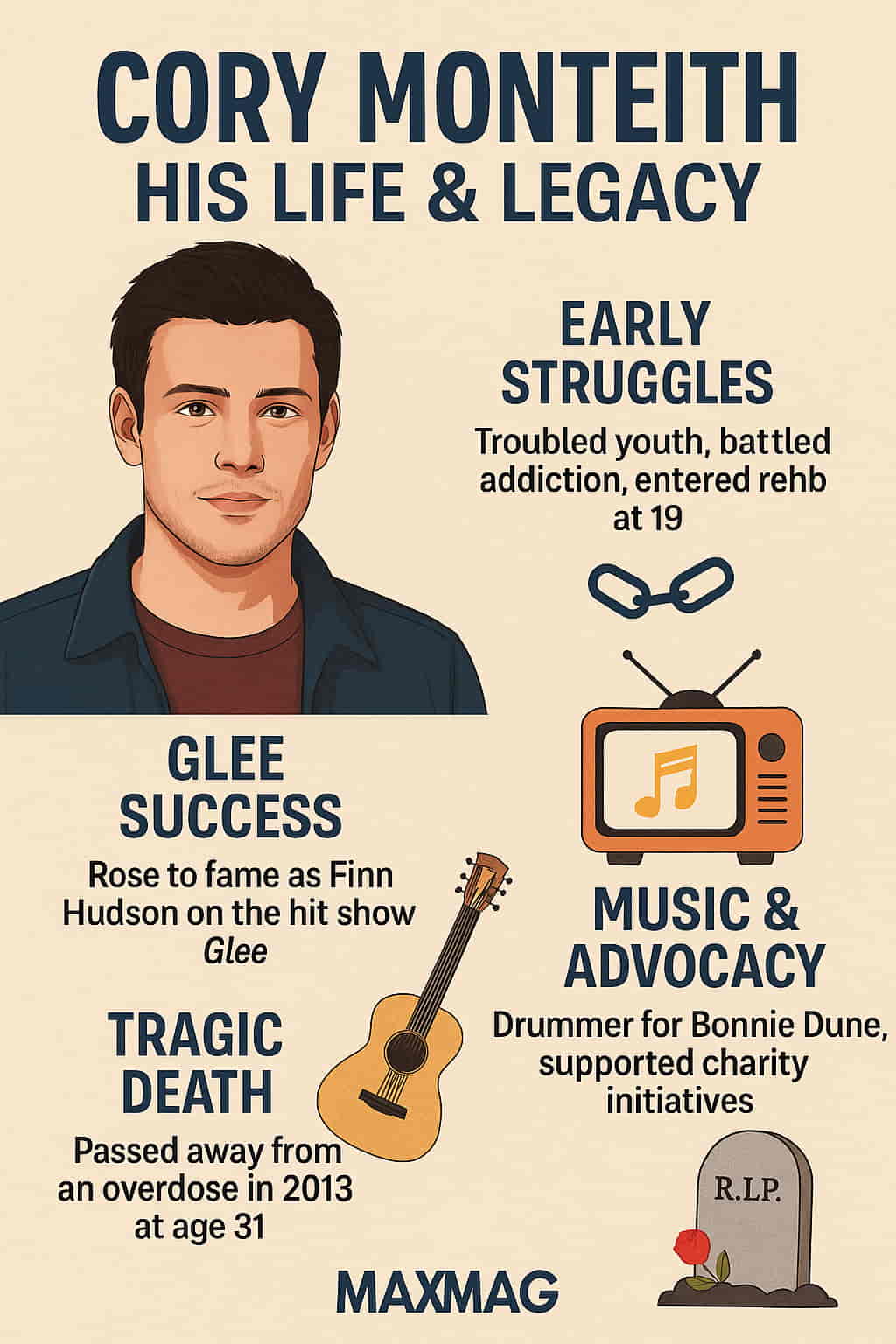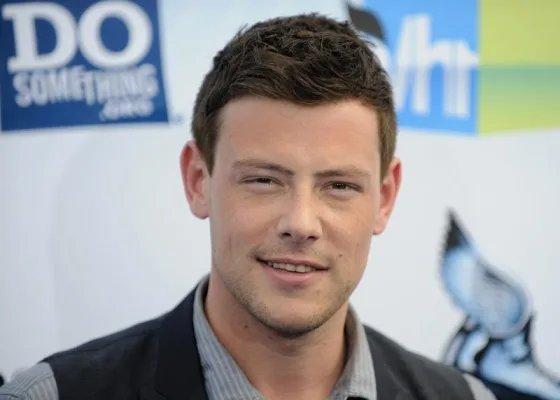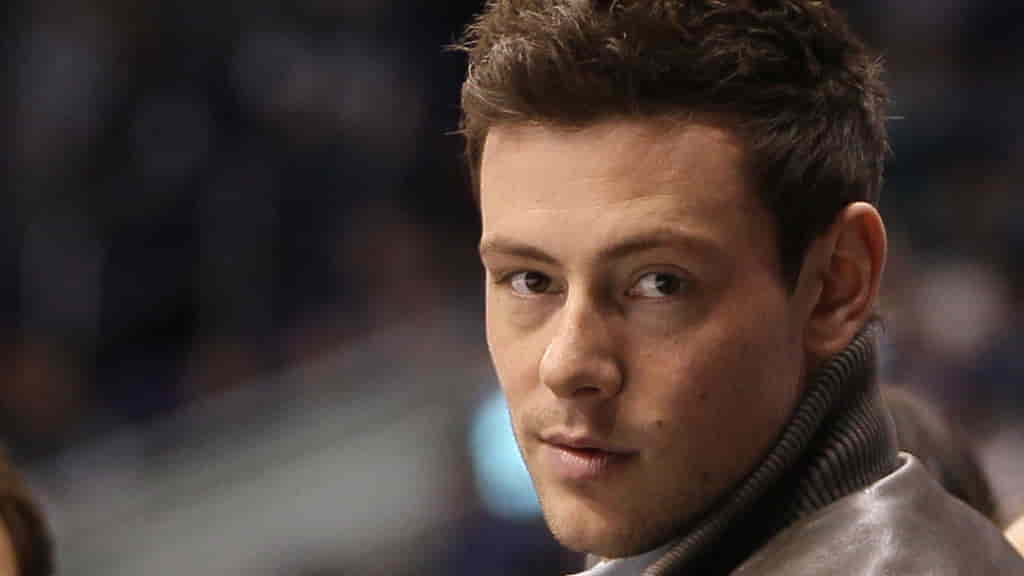
Some stars don’t shine for long—but their light never fades. Cory Monteith was one of them. A gifted actor, drummer, and advocate who rose to fame through the groundbreaking TV show Glee, he left an indelible mark on fans, colleagues, and the world at large. The Cory Monteith biography is not simply the story of a celebrity—it’s the story of a boy who carried pain quietly, found redemption through music and art, and used his platform to help others even while fighting his own demons.
His life was brief, his career cut short, and yet, Monteith remains one of the most emotionally resonant figures in modern pop culture. From his difficult upbringing in Canada to his starring role on a global television phenomenon, his story is one of struggle, sincerity, and soulful achievement.
The Unquiet Start: Childhood in Pieces
Cory Allan Michael Monteith was born on May 11, 1982, in Calgary, Alberta. His family fractured when he was just seven. After his parents’ divorce, Cory lived with his mother, Ann McGregor, a single working parent who raised him and his brother Shaun in Victoria, British Columbia. Though his childhood wasn’t marked by abuse or neglect, it was haunted by emotional disconnection. Cory once described feeling “out of sync” with his environment—never fully belonging at school, never quite sure who he was becoming.
By the time he was 13, he was already skipping school, self-isolating, and experimenting with alcohol and drugs. His behavior wasn’t rebellious for the sake of rebellion—it was a search for coping mechanisms. Over the next few years, he cycled through more than 15 schools, including alternative programs and dropout recovery courses. He tried to work—bus driving, Walmart greeting, roofing—but nothing stuck. As he entered his late teens, addiction deepened.
But within that chaos, something remained unshaken: a flicker of creative spark. Cory was drawn to rhythm and movement. He could teach himself to drum by listening. He didn’t know it then, but music would become his key to survival.
Intervention and the First Break from Addiction
By 19, his family could no longer ignore the downward spiral. His loved ones staged an intervention, confronting him with the truth he had long avoided. Cory later said it saved his life. He entered a rehabilitation program in British Columbia. For the first time, he had space to reflect—not just on what he had done, but on who he might become.
Rehab didn’t fix everything, but it gave him something rare: a beginning. Monteith returned from treatment with a new sense of possibility. He began attending alternative education programs to earn his high school diploma, and more importantly, he committed to working through his addiction with honesty and persistence.
What makes the Cory Monteith biography extraordinary is not that he went to rehab, but that he talked about it later. While many celebrities hide their struggles, Monteith was open. He didn’t glamorize pain—he honored the journey back from it.
The Actor Emerges
In his early twenties, Monteith enrolled in acting classes at the suggestion of a friend. The spark ignited quickly. He began performing in community theater productions and submitting for local roles in Vancouver. Hollywood North took notice.
His first television appearance came in the early 2000s in small guest roles: an ill-fated teen in Smallville, a suspicious character in Supernatural, and a love interest in Kaya. These performances weren’t headline-making, but they revealed something rare: warmth, depth, and a relatability that made casting directors pay attention.
He also worked in film—Final Destination 3, Whisper, and Deck the Halls—in minor parts that helped build his resume. Behind the scenes, he remained grounded, working service jobs and focusing on staying clean. He didn’t chase fame; he chased stability and purpose.

The Breakthrough That Changed Everything: Glee
In 2008, a casting call for a new musical TV show appeared. The show was called Glee, and the creators were looking for authenticity—real teenagers with real voices. Cory’s manager submitted a video of him drumming on Tupperware. It was charming, rough, and unique.
Fox requested more. Cory, not classically trained in singing, submitted a heartfelt recording of “Can’t Fight This Feeling”. A callback followed, then a live audition in Los Angeles. Within a week, he had landed the role of Finn Hudson, the all-American football player with an unexpected love for song.
H2: Cory Monteith Biography – The Making of Finn Hudson
Monteith’s performance as Finn Hudson became iconic. He wasn’t a polished Broadway star—he was the everyman, someone who sang because it meant something, not because he wanted the spotlight. That authenticity defined his character and made him the emotional center of the show.
The chemistry with his co-stars—particularly Lea Michele—was electric. Finn and Rachel became one of TV’s most beloved couples. But Monteith’s own contribution extended beyond scripted romance. He brought compassion to every line and sincerity to every musical note. His renditions of “I’ll Stand by You”, “Jessie’s Girl”, and “Man in the Mirror” remain fan favorites.
Off camera, Cory Monteith became the glue of the cast. He helped new actors feel welcome, supported his colleagues during personal difficulties, and actively participated in press tours, concerts, and charity events. He wasn’t just acting as the show’s “good guy”—he embodied it.
Behind the Fame: The Return of Old Struggles
While Glee catapulted him into global recognition, Monteith never stopped being open about his past. He gave candid interviews about his previous addictions, acknowledging that sobriety was a daily choice, not a guarantee.
Unfortunately, by 2012, signs of relapse began to surface. Those close to him noticed changes. Cory, recognizing the shift himself, voluntarily re-entered rehab in March 2013. The support from fans and cast was immense. Lea Michele stood by him, praising his strength.
He completed the program and rejoined the show. But the toll of fame, pressure, and relapse was severe. Cory tried—by all accounts, he tried with every ounce of will. But addiction doesn’t always yield to intention.
July 2013: The Tragic Ending
On July 13, 2013, Cory Monteith was found unresponsive in a Vancouver hotel room. He had died from a toxic combination of heroin and alcohol. He was only 31 years old.
The loss sent shockwaves around the world. News outlets paused regular coverage. Tributes appeared on social media within hours. From castmates to fans, everyone shared memories of his kindness, humility, and the way he made people feel seen.
The Glee cast gathered for an emotional tribute episode, The Quarterback, in October 2013. Songs like “Make You Feel My Love” and “Seasons of Love” took on new meaning. Lea Michele’s raw performance became one of the most powerful moments in modern TV history.
What Made Cory Different?
There have been many actors. Many television stars. But few who resonated as Cory did. Why?
-
He was authentic. There was no act—just a man trying to be his best self, even when that was hard.
-
He was open. He spoke about things most celebrities conceal: fear, addiction, imperfection.
-
He was generous. With time, with attention, with love.
-
He carried contradiction. He was joyful and hurting. Confident and insecure. Strong and fragile. And so, he was deeply human.
Music Beyond the Screen: Bonnie Dune and Artistic Expression
Outside of Glee, Monteith explored his musical roots through the indie rock band Bonnie Dune, where he played drums and occasionally sang backup. Their sound—California sunshine rock with introspective lyrics—matched Cory’s vibe perfectly. The band wasn’t a fame vehicle—it was an outlet.
He recorded and performed between filming seasons, often at intimate venues across California and Canada. For fans, these performances offered a different side of Monteith: the passionate musician who lost himself in rhythm.
Bonnie Dune’s music saw a resurgence after his passing. Tracks like “Shadow of a Man” and “Maybe Tonight” became tributes to Monteith himself—his presence forever in the beat.

Advocacy, Charity, and Purpose
Cory Monteith didn’t limit his influence to performance. He supported causes like youth addiction recovery, LGBTQ+ rights, and arts education. He frequently visited recovery centers, not as a celebrity spokesperson, but as someone who had been there.
One of his most impactful affiliations was with Project Limelight, a nonprofit offering free performing arts education to children from low-income backgrounds. Cory donated money, time, and visibility to the organization. After his death, the group created scholarships in his name.
His legacy is not defined by a relapse—it’s defined by the way he lived between the darkness.
His Love Story with Lea Michele
Cory and Lea’s relationship extended beyond Glee. They began dating in 2011 and quickly became one of Hollywood’s most talked-about couples. But theirs was not built on tabloids—it was built on real friendship and shared understanding.
In interviews, Lea described Cory as her “rock,” someone who helped her grow and believed in her more than she believed in herself. After his death, she mourned publicly and privately. Her albums Louder and Places contain several tribute songs, with lyrics hinting at pain, gratitude, and deep love.
Their love story, though brief, continues to resonate—proof that grief and love often walk hand in hand.
Why the Cory Monteith Biography Still Matters
The Cory Monteith biography is more than a celebrity’s timeline. It is a mirror for anyone who has struggled. It offers hope, vulnerability, and an understanding that we are all works in progress.
-
To the kid who doesn’t fit in: There’s a path, even if it’s winding.
-
To the person battling addiction: Recovery is a journey. Courage means trying again.
-
To the fan of good storytelling: Cory lived one. And it still teaches.
-
To the world: Kindness, honesty, and talent matter. And when shared, they can outlast even the person.
FAQ
What made Cory Monteith’s performance on Glee so powerful?
His natural sincerity and lack of formal training gave his performances authenticity and warmth. He was emotionally present in every scene.
Was he involved in charity or advocacy?
Yes. He worked with Project Limelight and several addiction support organizations, especially those focusing on youth.
Did Cory Monteith return to rehab before his death?
Yes. In March 2013, he voluntarily entered treatment, supported by his partner Lea Michele and the Glee cast.
What did he do outside of acting?
He was a drummer in the band Bonnie Dune, a public speaker on addiction, and a mentor to young creatives.
How is he remembered today?
Through tribute episodes, music, nonprofit scholarships, and the ongoing influence he has on fans navigating difficult personal journeys.





